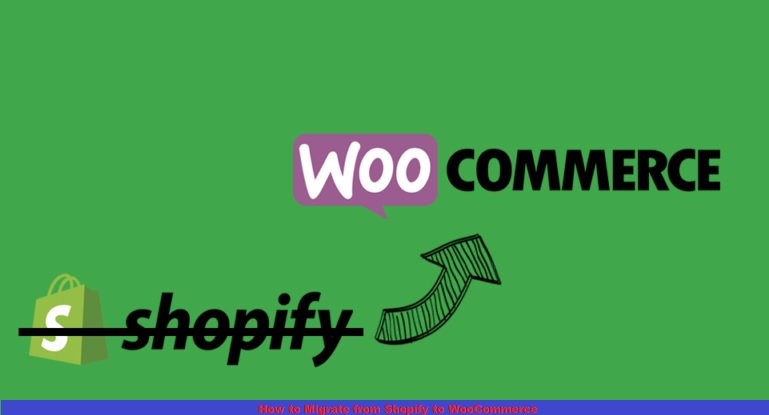Nowadays, E-commerce websites are so trendy for selling and retailing purposes. It allows and helps a person to expand their business online and get benefitted by the millions of communities of this world. They both permit a seller or retailer to set up an online store, but they differ greatly in many aspects. For example, Shopify is a fully hosted platform that eliminates the essence of backups and upgrades. However, this comes at a somewhat greater cost and gives you less control over your website.
WooCommerce, in contradiction, is open-source software that must be deployed on your own server. That means you have a lot more leniency with your online marketplace and may entirely personalize it to your liking. Due to these distinctions, Shopify consumers frequently prefer to migrate to WooCommerce when they become aware of the platform’s actual pricing and restrictions. Unfortunately, Shopify does not make it simple to transfer data to a WordPress-compatible format.
How Shopify is different from WooCommerce
Shopify and WooCommerce are the two most popular eCommerce platforms in the world, each with its own set of pros and cons. As a business owner, selecting the best eCommerce platform for your needs is vital to your success.
Before we begin our in-depth analysis of the two most successful ecommerce platforms on the website, it’s necessary that we address the fundamentals and showcase what distinguishes these platforms.
Shopify
Shopify is a fully hosted platform that eliminates the essence of backups and upgrades. It is a one-stop eCommerce solution that allows you to create an ecommerce marketplace, collect payments, and handle your merchandise all from a single platform without the worry of the technical stuff of, such as hosted services, privacy, storage, and so on, when you use Shopify. However, this comes at a somewhat greater cost and gives you less control over your website.
WooCommerce
WooCommerce is open-source software that must be deployed on your own server. It is a WordPress eCommerce application that is freely available. It enables you to choose the most advanced content management system (CMS) to manage an online business.
Also read: 7 Blogging Tools That Every Blogger Must Have
WordPress is an open-source website builder in the universe, driving 43 percent of all websites, and WooCommerce is the most popular online shopping platform, which many people are unaware of (yes even more in demand than Shopify). Because WooCommerce is easily accessible, you can simply change any part of your business and add a custom plugin. Hire the best Woocommerce Developer, you have a lot more leniency with your online marketplace and may entirely personalize it to your liking. The basis of difference is following:
- On the basis of Cost
WooCommerce is in fact the more affordable choice on the grounds that the product is free. In any case, keeping a genuine internet business stage on WooCommerce costs generally equivalent to, while perhaps not more than, Shopify. You’ll need to pay for extra charges, for example, an area name and facilitating, also the expense of each new expansion.
- Website speed
According to the analysis of this study’s performance tests, WooCommerce is actually quite slower than Shopify. The normal page stacking time for all followed retailers was 776 milliseconds, and the normal truck page stacked in 1.32 seconds. Shopify provides a very good overall user experience due to its rapid response times.
- Easy to use
Since WooCommerce is not a hosted platform, you must set up, monitor upgrades, keep copies, and ensure that your business is protected. The WooCommerce establishment is muddled since you should initially introduce WordPress. The significant benefit of Shopify is that it includes an online marketplace, therefore practically everything is easy. Because of its easy-to-understand interface, establishing up and keeping up with stores on Shopify appears to be a breeze.
- Themes and designs
Shopify has beautiful themes, but they are limited to what is available in its theme store. WooCommerce, then again, has plenty of phenomenal topics made by a flourishing engineer in the local area and project workers.
- Inventory Management
The WooCommerce platform is extremely flexible, and its inventory tracking tool is no exception. WooCommerce users can generate inventory reports and make adjustments to product properties. Shopify, like WooCommerce, gives businesses complete control over the Shopify stock tracking system. In the engine, you can follow stock, helpfully access stock notices, computerized buy orders, in-house income reports, etc. Moreover, with Shopify, you can physically or with the assistance of CSV documents transfer single or buck things, as well as clients, orders, and different information. Shopify clients may likewise exploit a plenty of stock instruments to assist them with working their organizations all the more easily.
- Blogs and Contents
WooCommerce flexes its muscles on blogs and in content. It acquires all of WordPress’ inventive composing blog capacities, making it the most confided in happy administration framework. The blog, on the other hand, is a regular component of Shopify.
- SOE
WooCommerce’s benefit is that it is based on a dedicated blogging platform. Hire the best Woocommerce Developer for your customers can use the WordPress publisher to change body content, basic URL redirections, meta descriptions, alt tags, and other page elements to improve product web-pages.
Also read: 10 Best On-page SEO factors that you should consider
Shopify, in contradiction, has specific SEO limitations. In truth, Shopify clients can’t totally change their URLs. This is because of Shopify’s unbendable Website URL, and a few components of your store URLs can’t be changed. Besides, making sub-classes on this stage is intense.
- Integration
As a WordPress plugin, WooCommerce users have access to WordPress’ massive plugin store, which has almost 58,000 free and premium plugins for all of your logistics, technological, and marketing requirements. Other than it, WooCommerce gives 592 eCommerce-explicit modules. Shopify has 5899 apps and extensions created by both in-house teams and third-party developers. By far most of the applications in its commercial center are assembled into classifications like stock administration, orders and transportation, deals and change, etc. These augmentations assist you with easily observing your E-Store while likewise driving more traffic and income. are assembled into classifications like stock administration, orders and transportation, deals and change, etc. These augmentations assist you with easily observing your E-Store while likewise driving more traffic and income.
- Payment gateways
WooCommerce accepts transactions via PayPal and Stripe, two well-known transaction gateways. Many local and less prominent transaction services are supported for payment systems.
Also read: How to Make Money With a WordPress Blog
Shopify has over 100 Payment Options to pick from, however you must pay a transaction cost of 0.5-2 percent relying upon the month to month plan you pick; the higher the arrangement you pick, the lower the exchange cost you pay for Shopify. It additionally has its own installment processor, Shopify Payments, which is totally free and incredibly easy to utilize.
- Security
While picking a facilitated eCommerce arrangement over an open-source stage, there is less to stress over with respect to safety and information security. All in all, Shopify seems to outperform WooCommerce as far as security.
- Support
WooCommerce, as most straightforward eCommerce platforms, doesn’t offer a visit component, communication, or messaging. Shopify, then again, is notable for its extraordinary client care, which is accessible 24 hours per day, seven days per week through telephone, email, and live talk.
Migrating from Shopify to WooCommerce
There are different Shopify to WooCommerce movement administrations accessible, but they are very costly. Their entire movement evaluates changes relying upon the number of things, clients, orders, and different standards. As a result, we created a simple importer tool to assist you in completing the Shopify to WooCommerce migration for free. That said however, let’s look at how you can migrate from Shopify to WooCommerce without engaging a costly migration agency by the following steps:
- Setting up WooCommerce– Before relocating your Shopify store to WooCommerce, you’ll have to introduce and set up WooCommerce. WooCommerce, aside from Shopify, is a self-facilitated platform. To set up WooCommerce, you’ll need a web hosting self-named account as well as a website address.
- Get Your Shopify Data – The second step is to download all the data of the Shopify.
- Import the information of Shopify to WooCommerce- After trading the information, you really want to import them into the WooCommerce store.
- Customizing your WooCommerce store- After successfully importing data to WooCommerce store, it’s time to finish configuring your WooCommerce store. This includes choosing a plan, introducing additional items for more decision and capacity, and choosing instruments that can assist you with extending your WordPress locales.
- Setting up diverts– So presently, WooCommerce store is completely functional, the following system is to design the important side-tracks from Shopify to WooCommerce. Web indexes and guests from your old Shopify site are consequently shipped off your new WooCommerce store. You will not lose any purchasers assuming they end up on some unacceptable site thusly.
Conclusion
We’ve made some amazing progress to look at WooCommerce and Shopify. If you want a solution with useful SEO capabilities, WooCommerce is the best to choose. Also, WooCommerce will be the best option if you want more support with your design, don’t mind fiddling, or your main marketing strategy is to drive visitors through content for search-engines. If you’re new to eCommerce or don’t want to tackle technical nuances, Shopify is the best to choose. Additionally, if you need to enquire things out and attempt a couple of items, pursue a 14-day free preliminary of Shopify right now to perceive how it functions.
Moreover, we perceive that choosing the best stage for your web business is a troublesome errand. As a result, before making a final decision, I urge that you devote some additional time reviewing extensive WooCommerce research as well as detailed Shopify assessment over the internet.







